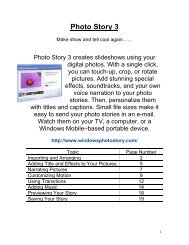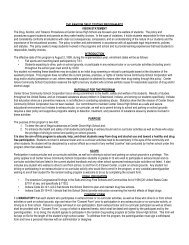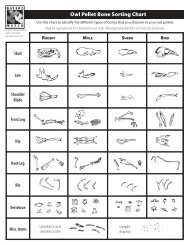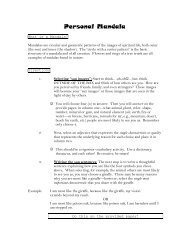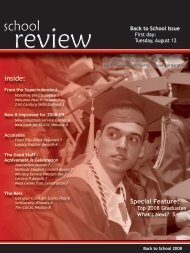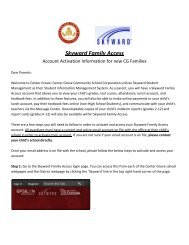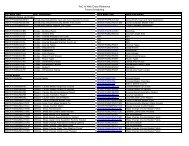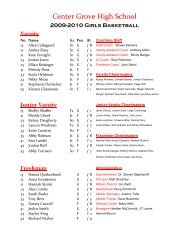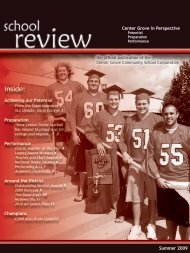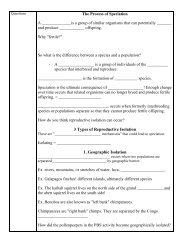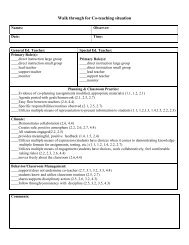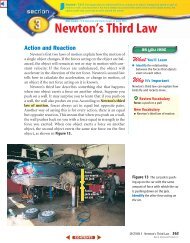The First 20 Days of Reading: Intermediate - Center Grove ...
The First 20 Days of Reading: Intermediate - Center Grove ...
The First 20 Days of Reading: Intermediate - Center Grove ...
Create successful ePaper yourself
Turn your PDF publications into a flip-book with our unique Google optimized e-Paper software.
Day 11<br />
Read Aloud, Shared <strong>Reading</strong>, and Independent <strong>Reading</strong><br />
Read Aloud: <strong>Reading</strong> is Thinking! – Different Kinds <strong>of</strong> Fiction (L)<br />
Today‟s lesson during the read aloud time is designed to provide time for teachers and students to explore the different<br />
kinds <strong>of</strong> fiction that are available to read from the classroom library before reading a personal narrative aloud. Plan on<br />
discussing 3-4 different types <strong>of</strong> fiction including but not limited to realistic fiction and personal narrative.<br />
Things to consider in planning for today‟s lesson:<br />
What characteristics <strong>of</strong> each kind <strong>of</strong> fiction discussed today do you want students to be familiar with at the end <strong>of</strong><br />
the lesson<br />
How will you make these characteristics public<br />
Is your library organized in a way that supports this discussion<br />
Do you want to label these genres in your classroom library<br />
It is suggested that the personal narrative that is read aloud today also be the resource for Shared <strong>Reading</strong>. One to two<br />
pages can be made into overheads in order to continue the conversation regarding characteristics <strong>of</strong> different kinds <strong>of</strong><br />
fiction.<br />
***<strong>The</strong> IPG focus for the week is sequence. You will take a close look at sequence later in the week, but you will want<br />
to plan some explicit talk about sequence as you look at fiction.***<br />
Shared <strong>Reading</strong>: Different Kinds <strong>of</strong> Fiction – Personal Narrative (L)<br />
This shared reading lesson is an extension <strong>of</strong> today‟s read aloud lesson. It is suggested that the personal narrative that is<br />
read aloud today also be the resource for Shared <strong>Reading</strong>. One to two pages can be made into overheads in order to<br />
continue the conversation regarding characteristics <strong>of</strong> different kinds <strong>of</strong> fiction.<br />
Points to reinforce prior to or during choral reading and discussion <strong>of</strong> the text:<br />
A Personal Narrative is characterized by an event, incident, or experience in the writer‟s own life or in the life <strong>of</strong> a<br />
fictional character.<br />
Personal Narratives can be categorized under both fiction and non-fiction, depending on the artistic license the<br />
writer has taken in conveying the story<br />
Teacher might say: A personal narrative is a very interesting genre or text type because it can be either fiction or nonfiction.<br />
It is fiction when the author has written the story in first person, using I, from the perspective or point <strong>of</strong> view <strong>of</strong> a<br />
made-up character. It’s non-fiction when the story is from the writer’s own life. Today we are looking at a fiction<br />
personal narrative.<br />
Independent <strong>Reading</strong>: Writing Responses to Your <strong>Reading</strong> (M)<br />
Today teachers will introduce students to the Reader‟s Response Letter that they will be writing each week. Students will<br />
have a first try at writing their own letter after reading an example from the teacher. This letter will be written on<br />
notebook paper in the Reader‟s Notebook each week.<br />
Fountas & Pinnell suggest that the teacher might say something like this: Together we have shared our thinking by talking<br />
about books I have read aloud to you and by talking about the books you have chosen to read during independent reading.<br />
You have talked about your thinking with your friends and during our conferences and you have kept a record <strong>of</strong> your<br />
thinking using sticky notes as you read. Now, instead <strong>of</strong> just talking about our reading and writing quick notes on stickies,<br />
you’re going to put your thinking on paper. When you write about your thinking, you can remember it and share it with<br />
others who read it. In our class this year, you’re going to share your thinking by writing your thoughts in a letter to me in<br />
your reader’s notebooks. Each week you are going to write one letter to me, sharing what you are thinking about the book<br />
you are reading. I will read your letter and write a letter back to you. I have written a letter to you today to share my<br />
thinking about a book I’m reading.<br />
Teachers will share their letter with the class and then ask, What do you notice about the letter I wrote<br />
After students make observations, teacher might say, This is how I will expect you to write your letters to me. You will<br />
write your best thinking in your best writing <strong>of</strong> a personal letter. Our letters will be a conversation between two readers.<br />
Today you will work on your first letter to me during our independent reading time. Use the blank paper in your reader’s<br />
notebook and place your notebook in the basket when you are finished. At the end <strong>of</strong> our independent reading time, I will<br />
ask a few students to share their letters with the class.<br />
For ideas on a teacher letter to share with your class and facilitating this conversation, see Fountas & Pinnell‟s Guiding<br />
Readers and Writers, Chapter 9, pg. 153.<br />
Austin Independent School District, Elementary Language Arts Department, ‟08-„09



